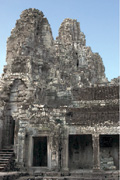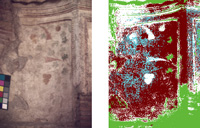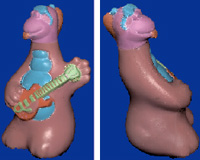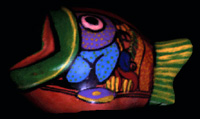研究紹介 - 光学
Surface Color Estimation | Surface Reflectance Estimation | Image Segmentation | Photometric Stereo | Byond Glass | Wavelet-Texture
Surface Color Estimation Using Multiple Images Taken at Different Times and Views
 To derive the actual and consistent surface colors, we have to estimate and then remove the illumination colors. We propose a method that estimates illumination colors by using only a single surface color but taken at different times and views. The method analyzes the color distribution in the input images and categorize pixels into small groups depending on their illumination colors. It estimates the illumination colors by using the candidate colors from those groups. The method succeeds in making the estimation robust and accurate, by constraining candidate illumination colors to be on a pre-set range of outdoor illumination colors. The method can be applied to create a realistic appearance of three-dimensional models with consistent colors.
To derive the actual and consistent surface colors, we have to estimate and then remove the illumination colors. We propose a method that estimates illumination colors by using only a single surface color but taken at different times and views. The method analyzes the color distribution in the input images and categorize pixels into small groups depending on their illumination colors. It estimates the illumination colors by using the candidate colors from those groups. The method succeeds in making the estimation robust and accurate, by constraining candidate illumination colors to be on a pre-set range of outdoor illumination colors. The method can be applied to create a realistic appearance of three-dimensional models with consistent colors.
発表論文
- Rei Kawakami, Katsushi Ikeuchi, "Stablizing Illumination chromaticity estimation using the illumination line segment", 10th IAPR Conf. on Machine Vision Applications (MVA2007), pp.437-440, Tokyo, Japan, 2007.
Efficient Estimation of Diffuse Surface Reflectance in an Outdoor Scene using Spherical Images
 To simulate the accurate appearance of an object, it is necessary to acquire not only the object’s shape but also the actual surface color, namely, the surface reflectance of the object. It is one of challenging issues specifically for outdoor environments, in which lighting conditions are not under control. We propose a new, efficient method to estimate reflectance parameters of diffuse outdoor objects from only one measurement with a spherical camera. Neither geometrical nor optical calibration is necessary. Using this method, we succeeded to calculate the illumination effect and acquire the surface reflectance.
To simulate the accurate appearance of an object, it is necessary to acquire not only the object’s shape but also the actual surface color, namely, the surface reflectance of the object. It is one of challenging issues specifically for outdoor environments, in which lighting conditions are not under control. We propose a new, efficient method to estimate reflectance parameters of diffuse outdoor objects from only one measurement with a spherical camera. Neither geometrical nor optical calibration is necessary. Using this method, we succeeded to calculate the illumination effect and acquire the surface reflectance.
発表論文
- Sonoko Okura, Rei Kawakami, Katsushi Ikeuchi, “Surface Reflectance Estimation of Diffuse Outdoor Object using Spherical Images,” Computer Vision and Image Media, January, 2008 (in Japanese) .
Multi-spectral Image Segmentation Using Normalized Cut
 Multi-spectral imaging is necessary for acquiring highly-accurate color information. We have developed the segmentation method based on spectral information for pigment analysis. However, the dimension reduction becomes an issue, since the dimension of spectra can be a hundred, while that of RGB images is only three. We propose an efficient dimension reduction method for multi-spectral image segmentation using Normalized Cut. Normalized Cut is a combination of a nonlinear dimension reduction and a clustering method; it reduces the spectral information and segments an image simultaneously. Previous methods such as PCA (Principal Component Analysis) cannot extract nonlinear features and therefore fail to segment images accurately, while the proposed method can, as the results show.
Multi-spectral imaging is necessary for acquiring highly-accurate color information. We have developed the segmentation method based on spectral information for pigment analysis. However, the dimension reduction becomes an issue, since the dimension of spectra can be a hundred, while that of RGB images is only three. We propose an efficient dimension reduction method for multi-spectral image segmentation using Normalized Cut. Normalized Cut is a combination of a nonlinear dimension reduction and a clustering method; it reduces the spectral information and segments an image simultaneously. Previous methods such as PCA (Principal Component Analysis) cannot extract nonlinear features and therefore fail to segment images accurately, while the proposed method can, as the results show.
発表論文
- T. Morimoto and K. Ikeuchi, " Multi-spectral Image Segmentation Using Normalized Cut," in Proc. of Meeting on Image Recognition and Understanding, July, 2008, to appear (in Japanese).
Multi-View Photometric Stereo using Rough Shape Data Application for Estimation of Reflection Parameters
 We present a new method to accurately determine surface normal distributions by using multi-view photometric stereo with a fusion of a laser range sensor. We can estimate reflection parameters accurately and robustly based on the normal distributions obtained. Here, we use specular-free images to estimate surface normals stably, even though the surface has specular reflection that the conventional photometric stereo cannot deal with. In several experiments we show the efficiency of this method by estimating reflection parameters robustly and making realistic synthesized images.
We present a new method to accurately determine surface normal distributions by using multi-view photometric stereo with a fusion of a laser range sensor. We can estimate reflection parameters accurately and robustly based on the normal distributions obtained. Here, we use specular-free images to estimate surface normals stably, even though the surface has specular reflection that the conventional photometric stereo cannot deal with. In several experiments we show the efficiency of this method by estimating reflection parameters robustly and making realistic synthesized images.
発表論文
- Tomoaki Higo, Daisuke Miyazaki, Katsushi Ikeuchi, “Multi-View Photometric Stereo using Rough Shape Data Application for Estimation of Reflection Parameters,” in Proc. of Meeting on Image Recognition and Understanding 2008
Photometric Stereo beyond Glass
 One of the necessary techniques for constructing a virtual museum is to digitize the artwork arranged inside a glass or acrylic display case without bringing the artwork out of the display case. By using photometric stereo, we estimate the shape (surface normal) and the reflectance (albedo) of the artwork arranged inside a transparent display case. If we illuminate the display case, the light will reflect at its surface; thus, we cannot apply conventional photometric stereo as is. In this paper, we propose a five-light photometric stereo that estimates the shape and the reflectance of an object that has specularities under the circumstances that the light is reflected at the surface of the display case.
One of the necessary techniques for constructing a virtual museum is to digitize the artwork arranged inside a glass or acrylic display case without bringing the artwork out of the display case. By using photometric stereo, we estimate the shape (surface normal) and the reflectance (albedo) of the artwork arranged inside a transparent display case. If we illuminate the display case, the light will reflect at its surface; thus, we cannot apply conventional photometric stereo as is. In this paper, we propose a five-light photometric stereo that estimates the shape and the reflectance of an object that has specularities under the circumstances that the light is reflected at the surface of the display case.
発表論文
- D. Miyazaki, K. Hara, and K. Ikeuchi, "Photometric Stereo beyond Glass: Active Separation of Transparent Layer and Five-Light Photometric Stereo with M-Estimator Using Laplace Distribution for a Virtual Museum," in Proc. of International Workshop on Photometric Analysis for Computer Vision, Oct. 2007.
- D. Miyazaki, K. Hara, and K. Ikeuchi, "Photometric Stereo over Glass," in Proc. of Meeting on Image Recognition and Understanding, pp. 1534-1539, July-Aug. 2007. (in Japanese)
Wavelet-Texture Method
 from different directions under different illuminations. In this paper, we propose a method that renders photorealistic images from a small amount of data. First, we separate the images of the object into a diffuse reflection component and a specular reflection component by using linear polarizers. Then, we estimate the parameters of the reflection model for each component. Finally, we compress the difference between the input images and the rendered images by using wavelet transform. At the rendering stage, we first calculate the diffuse and specular reflection images from the reflection parameters, then add the difference decompressed by inverse wavelet transform into the calculated reflection images, and finally obtain the photorealistic image of the object.
from different directions under different illuminations. In this paper, we propose a method that renders photorealistic images from a small amount of data. First, we separate the images of the object into a diffuse reflection component and a specular reflection component by using linear polarizers. Then, we estimate the parameters of the reflection model for each component. Finally, we compress the difference between the input images and the rendered images by using wavelet transform. At the rendering stage, we first calculate the diffuse and specular reflection images from the reflection parameters, then add the difference decompressed by inverse wavelet transform into the calculated reflection images, and finally obtain the photorealistic image of the object.
発表論文
- D. Miyazaki, T. Shibata, and K. Ikeuchi, "Wavelet-Texture Method: Appearance Compression by Daubechies Wavelet, Reflection Model, and Polarization," in Proc. of International Workshop on Photometric Analysis for Computer Vision, Oct. 2007.
- D. Miyazaki, T. Shibata, and K. Ikeuchi, "Wavelet-Texture Method: BTF Compression by using Daubechies Wavelet, Parametric Reflection Model, and Circular Polarizer," IEICE Transactions on Information Systems, Vol. J90-D, No. 8, pp. 2081-2093, Aug. 2007. (in Japanese)


